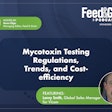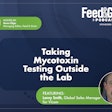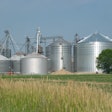The U.S. is in the middle of amassive expansion of its soybean crush capacity.
Demand and regulations requiring renewable aviation fuel have led to the industry investing over $6 billion in increasing soybean crush capacity over the next three to four years.
To get a better understanding of what's driving this trend and what its impacts may be on the grain handling and feed manufacturing industries,Steven Kilgerspoke with soybean expert Gordon Denny in this episode of theFeed & Grain Podcast.
Transcription of Feed & Grain Podcast with Gordon Denny, soybean expert.
Steven Kilger (00:00)
Hello, everyone! My name is Steven Kilger. I am the managing editor ofFeed & Grainand the host of the Feed & Grain Podcast. Today, I am sitting down with Gordon Denny. He is the general manager of Gordon Denny LLC, a consulting corporation specializing in the production, marketing and processing aspects of the soybean grain industries.
他是来和我谈最近的上升soybean crush facilities. I do not know if you noticed, but they are popping up all over the country, each one a very expensive build and getting ready to take in a lot of soybeans. So, I was interested in what is going on in that industry. And he's happy to tell us more. I want to thank everyone for listening today.
If you have a topic or a guest, you would like to see on the Feed & Grain podcast, please go tofeedandgrain.com/podcast. There is a little button on that page that you can click, and it will be a direct line to me, where you can suggest any topic or guests that you, please. But for now, thank you for listening. And, Gordon, thank you so much for being here.
So, the whole reason behind this is, I personally, I have been working in the grain handling and processing and the feed manufacturing industry for seven years now. And I have just noticed that lately, a lot of soybean crush plants seem to be either being built or coming online. And I was just really interested to hear your take on this important value add for producers. Can you start by just telling me a little bit about what a soybean crush plant is?
Gordon Denny (01:43)
Sure. So, I do a lot of consulting forUnited Soybean Board, theU.S. Soybean Export Council, those are my main two folks that I try to work with, focus on, because I just really, I have a lot of friends that are soybean farmers. Those are the guys I like to help. And so anyway, I will do anything that is positive for the U.S. soybean farmer. That is my piece and my upfront integrity, honesty, comment.
Kilger (02:07)
So, I like to tell people to tell people we're B2B, we're not you know, theNew York Timesor anything like that. We are always on our industry side.
Denny (02:16)
So yeah, you do not want to negate or talk derogatorily about your number one customer. So not only that, because of this, it is such a tough industry. And there is so many uncontrollable variables for farmers and processors and nutritionists. And the whole soy value chain must deal with that.
(I've got 43 years of direct hands-on experience in the soybean world, worked forBungefor several years, both as a soybean processing plant manager, and the Director of Procurement where we were we had divided the beans that the for the processing plants domestically. So anyway, that's all I've ever done since I got out of the Marine Corps in 1980 is working in the soybean business and even prior to that I was on the backwoods southern Indiana hillbilly farm kid, and we had a small farmers that actually fed soybean hay to our beef cattle back then. So, it's put kids through college bought houses bought the clothes I'm wearing, food, you name it, soybeans are my thing.
And I have a unique experience. I do not know of anyone else dumb enough to done both, where half of my career was in the processing side of the business and the other half was in the commodity trading procurements side of the business. Those are usually mutually exclusive. But I saw an opportunity to help both those entities, they usually work against one another that are jealous of one another. They don't have mutual goals. But I saw an opportunity way back when that I understand both sides of the equation and maybe help to get those groups to work closer together.
So, soybean processing plants, there are 61-62 of them in the US today that are operating. And they can range anywhere from 30,000 bushels/ day on up to, I do not know 250-300,000 bushels/day. And I have done some calculations there on the average size based on the company and an open representation. So, they cost if you were building a brand-new plant today, it is going to be 350 to $450 million. So, it is an expensive undertaking.
I think the industry is spending five and a half to $6 billion over the next three to four years to get new processing plants built to increase the crush capacity. And the demand is primarily coming from the renewable diesel and the sustainable aviation fuel trends that initiated in California. But they're now, because of the sustainability, because of the carbon intensity, because of the low-cost fuel standard or low carbon fuel standards. All those things are going to push us away from fossil fuels, and work towards a sustainable, renewable, greener fuels for both vehicles and airplanes.
So, that is the real impetus. And it is one of those things where it feels like ethanol back 20 years ago or so, 25 years maybe. There are four things that government can do to create artificial economics to incentivize new companies. You can mandate it, you can give tax credits, you can use tariff protections … there is one other I can't think of offhand that's along the tax credit lines.
But anyway, we did it for ethanol. And now that is dying out a wee bit and probably has seen its hay day. So, we're shifting over to the renewable diesel and sustainable aviation fuel, and we're burning food oils, food grade oils, like soybean oil, or canola oil, or palm oil or something that can be converted to having a similar molecular structure as petroleum oils. Credit mandates, subsidies and tariff protection was the four things I tried to remember that the government is doing to get the incubation of new companies spurred along.
There's two things that the soybean industry reacts to fear and greed. And FOMO, Fear of Missing Out, is a huge incentive for soybean processors. The Big Four, and it's not ABCD, never really was domestically, it'sADM, Bungie,CargillandAg Processing, ABCA would be the proper acronym.Louis Dreyfusus only has one domestic plant, they do export lots of stuff, they trade lots of stuff, Argentina, and South America wise, they're big. But in the US, it's ABCA.
(So those four guys control about 70 or 75% of the US domestic crush, that percentage is probably going to come down in the future as we have new entrants into the industry, even though all those companies are expanding or building new plants, but they're only doing it to provide soybean oil to the refineries that will provide renewable diesel in those states that have mandated it. And there are several of those besides California, others that are tagging along.
The soybean meal is going to be the real problem if we increase capacity, and I think my projections show about a 28% increase in crush capacity in the next three to four years. The oil can go away, that's not a huge problem, because the demand is going to be there, the refineries are already converting over, that's going to be taken care of. But the soybean meal, and you can't really store soybean meal, it takes up a lot of volume, it's not easy to handle once it sets for a while. So, getting rid of the soybean meal is going to be a significant issue and opportunity. We do increase consumption of soybean meal every year, but this is going to be a cathartic jump in production.
So, it's going to take some adjustments in the industry, we're going to have to export more soybean meal, we're going to have to export more poultry. And we are going to have to grow the poultry industry in the U.S. to consume more soybean meal. 65% of the soybean meal produced in the United States today goes into something with a feather, a broiler, a layer or a turkey. Feathers are the number one friend of soybean meal in the United States.
Pork consumes, depending on the year and exports, 20 to 24% of the soybean meal that is produced in the United States. China exports on pork are down, and China is self-sufficient. Their pork processors have good margins. So, if we could get to the point where our soybean meal is going to China. China has always bought beans from the world, from both Brazil and the US, but I think in the future, we could see China starting to import soybean meal from the US because the values will be so low, so inexpensive.
In the past Argentina has been the number one soybean meal exporter in the world in a big way. Brazil export soybeans, U.S. exports beans, Argentina exports, soybean meal, That is they have differential export taxes that the way the industry is set up, over the years. But now, Argentina is starting to shut down, some of their crush plants and their crush plants are much less efficient. And they operate at much lower run rates. Meaning U.S. plants will average around 92% of maximum crush capacity, and Argentina may be at 55%. And it's a high fixed cost industry; you want to run as many bushels of soybeans through your plant as possible to keep your fixed costs low.
So anyway, so I think the U.S. will take the place of Argentina, and we are going to have to export. So anyway, big expansion, lots of meal, lots of changes, and an unprecedented amount of capital being spent and invested in soybean processing. The main impetus is renewable diesel which started in California. Now followed by sustainable aviation fuel. And, you know, the new government legislation that has recently been passed will continue to fund mandate subsidized tax credits, tariff protection, all those types of things to ensure that it’s successful, they're incentivizing.
Kilger (11:27)
Fascinating because it does seem like the U.S., at least, has a really good potential to become a mecca for this. I mean, we have the soybeans, and we're investing in the infrastructure, or companies are, so we can become one of those exporters of soybean oil, fuel and soybean meal. I mean, obviously, soybean farmers are really excited about this. Is it just because it is another market to sell their soybeans to? Are they getting a premium if they sell to a facility, soybean crush facility or just, you know, the markets better?
Denny (12:10)
More demand is better, I guess. And then you can break the demand down because it is more places to sell. And some of these plants are being built in processing deserts, meaning we have not had the crushing capacity needed in certain areas of the country. So, we are now filling in those gaps in the soybean processing and crushing industry. And this renewable diesel trend has started. But they both see increased demand, they see a lower cash basis, and their local cash basis will be much better. We are going to probably see increased soybean plantings and acreage in the future. They will have less transportation tied up to get their soybeans taken to a premium market.
Processors operate throughout, typically 24 hours a day, seven days a week, 350 days a year. So, the demand is very steady. It is not like the export demand can fluctuate seasonally in South America. Domestic processors provide a steady, regular source of demand. And right now, there are people in the United States paying $2.25-$2.40/bushel over the November futures in Chicago. So, they didn't they didn't plan. That's an unbelievably high cash basis, even though the markets are inverted in Chicago. But somebody didn't plan ahead. Well, if I had been the soybean buyer at this point and had to pay that much, I probably would be looking for another job.
But anyway, and transportation is going to be a huge issue in the future, particularly on the rail as the railroads do not have, I mean, they're short crews, and they're short power units. So, they're going to have to, and they’re probably petitioning, working politics in Washington to get tax breaks or incentives or something else to help them out as well. But we have lost a crush this year because the railroads could not service the existing plant capacities. So, we are going to need new rail cars to be built. We are going to need more railroads, switch engines and crews to provide the service for the 28% increase in crush capacity. A lot of that will have to be moved into the export channels. So, in the previous years, you know, some of it goes away by a truck just in the local truck market. So, that market is currently satiated or saturated or both, but we can't expect that market to grow very much. Railcars cars and the size of the poultry industry. And again, poultry, something with a feather, is just soybeans, number one friend.
Kilger 15:18
Yeah, well, I know hopefully, you know, the strike doesn't happen, and we don't have a catastrophe this, this fall with rail?
Denny (15:27)
Well, the President can step in, and he can mandate. I forget what the legal phrase is where a cooling-off period and then they are forced to come back to work, and then they introduce federal negotiators. Because it is a critical part of the infrastructure, with food prices and everything else where they are, I'm sure that if he's awake, that Biden will look for something to happen.
Kilger (15:53)
Yeah, let's hope. Let us hope. I'm sure he will because we really can't. But let's face it, it's been a battle of trying to get the railroad companies to update infrastructure and cars and get more and more. While they are trying to run at the lowest possible cost.
Denny (16:12)
我忘记它叫什么。和本月的家伙ituted it a few years ago just died recently. And he was a CEO for a couple of different railroads, class ones. But it was a least-cost formula where they want to schedule the service, and you have to line your cars up. They're coming in every day at five o'clock to pick up your 50 cars of meal or oil or whatever. And if you're not ready, then we're going to leave.
So, they improve their efficiencies and dwell times, and car returns and all that. But the customers bore the cost. It shut plants down, if they would have a railroad problem somewhere, chickens would go hungry. I think we are going to have to get away from that old mentality. They have a monopoly, but the government is going to have to make sure that that monopoly facilitates U.S. production and trade and food costs and helps to feed the world.
有一件事我可以解决作为一个关键短语be, is that soybean oil for renewable diesel is going to subsidize soybean meal prices. So, I think protein in almost every form, and that includes chicken and pigs. Beef eats 7% or 8% of U.S soybean meal production, and dairies another 7% or 8%. Aquaculture is next to nothing at .7%.
Oil, and renewable diesel and sustainable aviation fuel will subsidize the price of protein. Therefore, I think helping to feed humans. I do not think we are starving for fat in the world. I think we're more starved for protein. So, in that respect, I can see protein in all forms, even artificial meat, whatever term you want to use for Impossible Burger and Beyond Meat and all as vegetable meat. I see protein, and almost every form getting cheaper and value cheaper in price.
Kilger (18:20)
Well, that'd be a welcome relief at the grocery store; it hasn’t been going that way lately.
Denny (18:27)
No, we are what 12% at groceries and 8% in restaurants over the last year.
Kilger (18:33)
So yeah. Well, you have answered all the questions I had. I want to thank you so much. Sure. Great talking to you. It's an industry that we haven't covered enough, and I really want to continue to expand our coverage of it, especially as it becomes more and more important. And we start having more and more soybean meal that we will be getting added to animal feed and things like that.
DENNY (19:01)
All right. Okay, thank you.



















